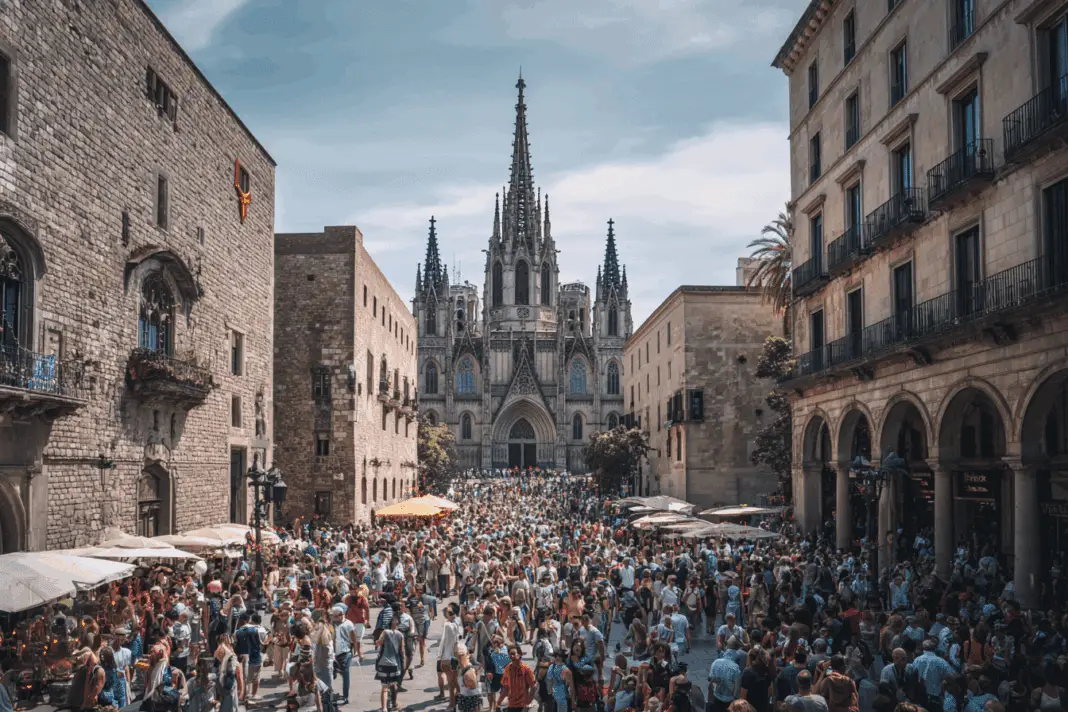Getting robbed while traveling might seem like one of those things that only happens to other people, but the statistics tell a different story. Tourist hotspots across Europe see thousands of pickpocketing incidents every year, with some locations being so notorious that local police have stationed extra officers just to handle the volume of reports. From Barcelona’s bustling walkways to Rome’s ancient monuments, certain destinations have become virtual goldmines for skilled thieves who’ve turned tourist targeting into an art form.
Las Ramblas turns visitors into easy targets
Barcelona’s famous pedestrian street holds the unfortunate distinction of being the world’s pickpocketing capital. During peak tourist season, this iconic walkway becomes so crowded that moving through it feels like swimming upstream through a sea of people. The narrow space forces tourists to bump into each other constantly, creating perfect cover for thieves who can brush against victims while lifting wallets, phones, or cameras without anyone noticing.
The sheer volume of people creates a sensory overload that makes visitors drop their guard completely. Street performers add another layer of distraction, with tourists stopping to watch shows while thieves work the captivated crowds. Professional pickpockets have perfected their craft here, often working in teams where one person creates a distraction while another makes the grab. The key to staying safe involves keeping all valuables in front-facing, zipped pockets and maintaining awareness of anyone who gets unusually close.
Eiffel Tower visits come with hidden risks
The walk from the metro station to Paris’s most famous landmark creates a perfect storm for theft. Tourists emerge from underground stations already disoriented, then navigate busy streets while craning their necks to catch their first glimpse of the tower. This combination of distraction and excitement makes visitors completely oblivious to their surroundings. Pickpockets position themselves strategically along the main approach routes, targeting people who are clearly tourists based on their behavior and appearance.
The area around the tower itself presents additional challenges, with vendors selling souvenirs and tour guides approaching potential customers. These legitimate interactions provide cover for thieves who can blend in with the crowd of people trying to get tourists’ attention. Travel experts recommend avoiding flashy jewelry or openly displaying expensive cameras and phones. Smart visitors prepare for their Eiffel Tower visit by securing valuables in money belts and staying alert to anyone who approaches them, even if they appear to be offering legitimate services.
Trevi Fountain traditions create perfect distractions
Rome’s legendary fountain attracts visitors who are focused on one thing: making their wishes come true by tossing coins over their left shoulder. This beloved ritual requires tourists to dig through their wallets or purses to find coins, then turn their backs to the crowd while making their throws. During these moments, visitors become completely vulnerable to thieves who position themselves in the densely packed area around the fountain’s edge.
The fountain generates roughly 3,000 euros in thrown coins daily, which gives some indication of how many people go through the wallet-opening, back-turning routine that pickpockets love. The crowds are so thick that people constantly bump into each other, making it nearly impossible to identify who might be deliberately pressing against you versus accidentally jostling in the crowd. Experienced travelers recommend having coins ready before approaching the fountain and keeping bags securely zipped and positioned in front of the body during the coin-throwing ceremony.
Prague bridges combine tourism with theft
Charles Bridge presents a unique challenge because it funnels all foot traffic into a narrow stone walkway while simultaneously encouraging tourists to stop and touch specific statues for good luck. The statue of St. John of Nepomuk has become particularly problematic because the tradition requires visitors to place their hands on the bronze figure while making a wish. This ritual creates predictable moments when tourists are distracted and stationary, making them ideal targets for skilled pickpockets.
The bridge’s medieval design means there’s nowhere for crowds to spread out, forcing everyone into close physical contact. Street artists and musicians add to the carnival atmosphere, but they also provide additional distractions that thieves exploit. The combination of narrow spaces, ritual touching, and entertainment creates what security experts call a “perfect storm” environment for theft. Safety specialists suggest emptying pockets before crossing the bridge and keeping bags attached to your body at all times, even when participating in the statue-touching traditions.
Sacré-Coeur attracts organized theft rings
The approach to Paris’s hilltop basilica has become notorious for sophisticated pickpocketing operations that often involve multiple people working together. Teams of thieves position themselves along the walking paths and at the entrance, with some members acting as spotters who identify promising targets while others execute the actual thefts. The scenic climb to the church requires visitors to navigate stairs and winding paths, creating natural chokepoints where crowds bunch together.
These organized groups have perfected distraction techniques that can fool even cautious travelers. One common approach involves someone asking for directions or trying to engage tourists in conversation while accomplices work from behind or to the sides. The breathtaking views provide another natural distraction, as visitors stop to take photos and admire the panoramic scenes of Paris below. Security experts warn that anyone who approaches you with questions has likely been watching long enough to know exactly where you keep your valuables, so the moment someone tries to get your attention, your first move should be securing your belongings.
Colosseum lines test your patience and security
Rome’s ancient amphitheater draws millions of visitors who often find themselves standing in lines that can stretch for hours during peak season. These extended waits create ideal conditions for theft because people gradually become more relaxed and less vigilant as time passes. Tourists start conversations with fellow visitors, check their phones, dig through bags for snacks or water, and generally let their guard down as the initial excitement of arrival fades into boredom and frustration.
The lengthy queues also give pickpockets plenty of time to observe potential targets and plan their approaches. Thieves can watch for several minutes to see where people keep their phones, wallets, and cameras before making their move. The crowded conditions mean people are constantly shifting positions, bumping into each other, and creating physical contact that provides perfect cover for skilled hands. Travel advisors strongly recommend purchasing tickets in advance to minimize time spent in vulnerable queuing situations, and maintaining awareness of your surroundings even during boring waits.
Prague squares become seasonal hunting grounds
Old Town Square transforms into pickpocket paradise during major holidays and events, with Christmas markets being particularly problematic. The seasonal celebrations draw enormous crowds who are focused on shopping, eating, and enjoying the festive atmosphere rather than protecting their belongings. Market stalls create maze-like conditions where people constantly bump into each other while navigating between vendors, and the holiday spirit makes visitors more trusting and less suspicious of strangers.
The famous astronomical clock adds another layer of complexity because it draws crowds at specific times when people gather to watch the hourly show. These predictable gathering times allow thieves to position themselves strategically and work the concentrated crowds when everyone’s attention is focused upward. Holiday shoppers carrying cash and making frequent purchases create additional opportunities for theft. Crime statistics show that pickpocketing incidents spike dramatically during Christmas, Easter, and other major celebrations, making it essential to take extra precautions during these periods.
Public transit creates mobile crime opportunities
European metros, buses, and trams that serve major tourist destinations have become favorite hunting grounds for pickpockets who exploit the unique vulnerabilities of public transportation. The confined spaces force strangers into close physical contact, while the stop-and-go motion of vehicles creates natural jostling that provides perfect cover for theft. Rome’s bus route 64, which connects major tourist sites, has earned particular notoriety for the frequency of pickpocketing incidents.
The most dangerous moments occur during boarding and exiting when crowds push together at doors, and thieves can grab items before disappearing into the crowd or jumping off at stations. Some pickpockets work near subway turnstiles, timing their thefts for moments when victims are stuck behind barriers and cannot pursue them. Transportation security experts recommend wearing day packs on your chest when using crowded public transit and maintaining physical contact with all belongings during the chaotic moments of boarding and exiting vehicles.
Train stations target overwhelmed travelers
Major railway stations across Europe present particular challenges because they catch visitors at their most vulnerable moments. Newly arrived tourists are typically jet-lagged, disoriented, and burdened with heavy luggage while trying to figure out directions to their hotels. This combination of factors creates ideal conditions for theft, as travelers are mentally overwhelmed and physically encumbered, making them easy targets for opportunistic criminals.
The chaos of train stations provides excellent cover for thieves, with constant crowds, announcements, and movement creating sensory overload that masks criminal activity. Pickpockets often work in teams near information boards and ticket machines, targeting people who are stopped and distracted while trying to navigate unfamiliar systems. Security professionals note that the moment of stepping off a train with luggage represents peak vulnerability, when travelers should take extra care to maintain awareness of their surroundings and keep valuables secured in money belts or other protected locations.
Understanding these high-risk locations helps travelers prepare mentally and physically for situations where theft is most likely to occur. The common thread running through all these hotspots is distraction combined with crowding, which creates perfect conditions for skilled pickpockets to operate undetected. Smart preparation, constant awareness, and simple precautions like money belts can dramatically reduce the risk of becoming another statistic in Europe’s ongoing battle against tourist-targeted crime.

